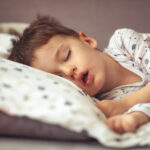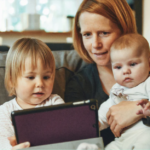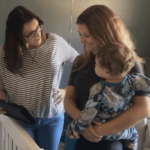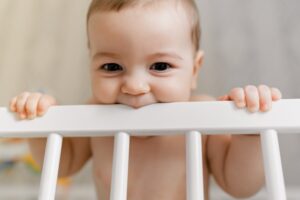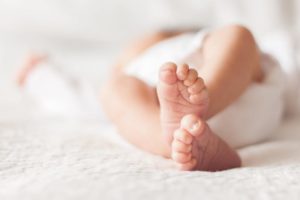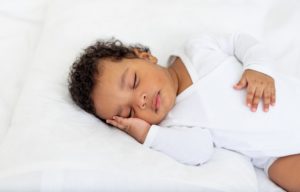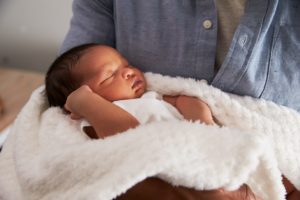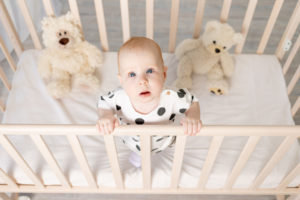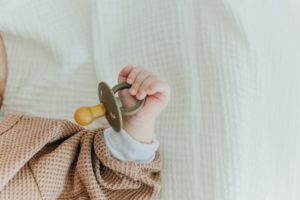When you buy through our links, we may earn a commission. Products or services may be offered by an affiliated entity. Learn more.
How to Dress a Baby for Sleep
Few topics can be as stressful for parents and caregivers as a baby’s sleep. It is natural to want to help a baby sleep as well as possible, but parents are often unsure of the best way to dress their baby for sleep so they do not overheat or get too cold.
Beyond comfort, dressing a baby for sleep is a matter of safety. Babies should be dressed in layers that suit their bedroom’s temperature to avoid overheating. Experts also advise against covering babies with blankets or putting anything on or over their head during sleep to prevent suffocation or strangulation.
How Should You Dress a Baby for Sleep?
Experts recommend that parents and caregivers dress a baby for sleep with one or more layers of sleepwear to provide enough warmth so their baby can sleep without a blanket. At the same time, it is important to prevent overheating , so sleep clothing should not be too heavy or cover a baby’s head.
To promote safe sleeping, blankets should be kept out of an infant’s crib. Blankets can increase the risk of suffocation, strangulation, sudden infant death syndrome (SIDS). The presence of a blanket may also cause a baby to become stuck in a dangerous sleep position.
To avoid these risks, it is best to dress a baby in clothing that keeps them at a comfortable temperature so that a blanket is unnecessary. Sleep clothing can be layered to suit the bedroom temperature and provide any needed warmth. In many cases, a onesie can be an effective primary layer of sleepwear.
As a general rule, parents and caregivers should dress a baby with only one more layer than an adult would need to stay warm in that same bedroom. This rule can help avoid over-bundling, which can lead to safety risks from overheating.
“With all the contradictory information regarding what a baby should wear to sleep, remember that less is more. Aim for lightweight clothing such as a onesie and a sleep sack to help the baby feel secure and cozy without over-bundling.”
Dr. Nilong Viyas, Pediatrician
According to experts, wearable blankets or sleep sacks can be safe and effective types of sleepwear. However, these products require certain precautions. If a sleep sack or wearable blanket restricts a baby’s movement, it should not be used once a baby starts trying to roll over on their own, which may start when a baby is 2 months old.
Additionally, parents and caregivers should make sure that nothing covers a baby’s head or face. Hats and other head coverings may cause overheating or reduce an infant’s ability to take in enough oxygen while asleep.
Help Your Baby Sleep Better With Pediatric Sleep Coaching
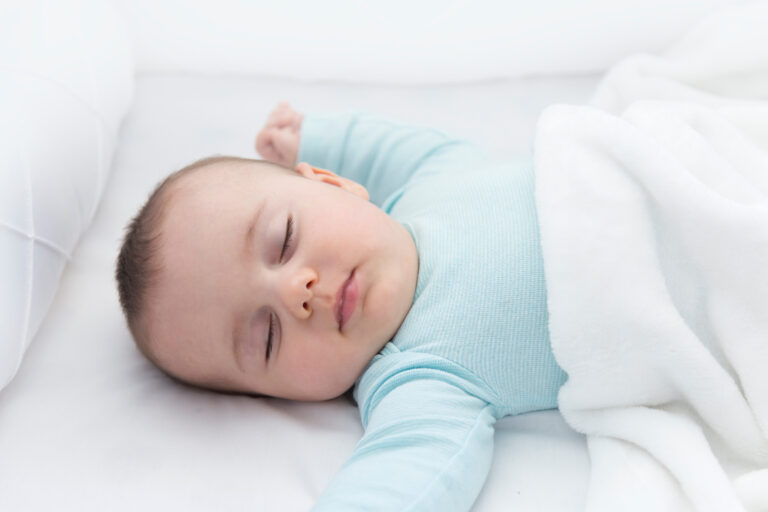
our partner at sleepdoctor.com
Learn More“Life-changing! My anxiety about my son’s sleeping habits were immediately reduced after talking to Sara. She went above and beyond to tailor a schedule to our goals, answer our questions, keep us on track, and check in to encourage us when we just thought we couldn’t do it anymore.”
Rachael B. – Verified Customer
Should You Swaddle Your Baby?
Swaddling involves closely wrapping a baby in a thin blanket. Expert organizations advise that swaddling is an option for newborns, but that parents and caregivers should consider its potential benefits and risks when deciding whether to swaddle their baby. Being swaddled can calm some babies and may help them sleep. However, there is no evidence that swaddling is any safer than dressing a baby in layered sleepwear.
In fact, swaddling can be risky once a baby starts rolling over on their own, because it is very difficult for a swaddled baby to turn again if they wind up face-down. For most babies, this means swaddling should stop at around 3 months of age, but some infants may start rolling over at 2 months.
Other risks of swaddling include overheating and wrapping a baby too tightly, which may put excess pressure on their hips or make it difficult for them to breathe well.
How to Swaddle a Baby
When swaddling a baby, it is best to use a blanket that is light and thin. A caregiver can place the baby on top of the spread-out blanket, then fold it around the baby’s torso and then the rest of their body. The baby’s arms can be inside or outside the swaddle, as this has no impact on their safety.
Several other tips can also be helpful for safe swaddling.
- Put the baby on their back: It is essential to always make sure that a swaddled baby is placed in their crib on their back. Being put to bed on their stomach or side can create a higher risk of suffocation.
- Do not wrap too tightly: A baby may struggle to breathe properly if swaddled too tightly. Too much pressure from a tight swaddle can also damage an infant’s hips.
- Monitor the baby’s temperature: Swaddling can trap heat, especially if the blanket is too tight. Parents and caregivers should keep an eye out for any signs that a swaddled baby is too hot. Signs of overheating can include sweating, flushing in the cheeks, and skin that is hot to the touch.
- Avoided weighted blankets: Experts recommend against using any kind of weighted blanket or weighted swaddle for safety reasons. There is limited information about the safety of weighted swaddling products. The added weight may lead to overheating or make it more difficult for a developing baby to breathe, which can lead to suffocation.
- Know when to stop swaddling: Swaddling should usually stop whenever an infant begins to make efforts to roll over on their own.
Parents and caregivers with any questions or concerns about the safety or appropriateness of swaddling should consult with a pediatrician for specific medical advice.
How Do You Know if Your Baby Is Comfortable?
Dressing a baby for sleep should involve helping them maintain a comfortable body temperature. Knowing what to look for can help keep a baby from becoming too hot or too cold.
Experts caution against dressing a baby too warmly during sleep because of the health risks of overheating. Potential signs that a baby is too hot include:
- Sweating
- Hair that is damp
- Skin that is red or shows signs of rash
- Reddened cheeks
- Quickened breathing
- A chest that is noticeably hot
Tips for Baby Sleepwear
The number of sleepwear products on the market can be overwhelming, so parents and caregivers may have a hard time knowing what is the safest option for a baby’s sleep. Several tips can be helpful when looking for infant sleepwear.
- Know how much sleepwear they need: Because of how quickly babies grow, it is not necessary to have a lot of clothing for sleep. Usually having four to six pieces of sleepwear is enough to make sure something is always clean and dry when it is time to get a baby ready for sleep.
- Try gown-like sleep clothing: Many parents and caregivers prefer sleepwear that is easy to open at the bottom. This design allows it to be quickly pulled up and down when a baby’s diaper needs to be changed during the night.
- Opt for light layers: Having several thinner layers makes it simpler to adjust a baby’s clothing to match the bedroom temperature with less risk of overheating.
- Avoid safety hazards: No items—including pacifiers—should be tied to a baby’s clothes, since strings and ties raise the risk of accidental strangulation. Buttons and other small objects on clothing should be removed if they are loose, since they could fall off and become choking hazards.

Recommendations for Safe Sleeping
Expert organizations like the American Academy of Pediatrics and the National Institute of Child Health and Human Development provide specific recommendations to encourage safe sleeping for babies. These tips are intended to reduce the risk of sudden infant death syndrome (SIDS), which is most common from birth to 6 months but can occur in babies up to 1 year old.
Parents and anyone who cares for infants can focus on implementing core recommendations that promote safe sleep.
- Back sleeping: Putting a baby to sleep on their back is crucial for their safety. Babies who sleep on their backs are the least susceptible to SIDS.
- Room sharing: Most experts suggest having a baby sleep in the same room as adults but on a completely separate sleeping surface. Experts often recommend room sharing until a baby is at least 6 months old.
- Using firm and flat sleep surfaces: To prevent SIDS, any surface a baby sleeps on should be level and made with firm materials. Sleep surfaces should be covered with only a fitted sheet that will stay firmly in place.
- Removal of blankets and soft objects: Any soft items in a baby’s crib, including pillows, blankets, bumpers, and stuffed animals, increase the risk of suffocation, SIDS, and strangulation. These should be kept out of a baby’s sleep area.
- Checking crib construction: Both cribs and crib mattresses have to adhere to safety guidelines created by the Consumer Product Safety Commission. Before purchasing or using any crib or mattress, caregivers should ensure that the product is compliant, has not been recalled, and is in good condition with no missing parts.
- Giving a pacifier before sleep: Studies suggest that providing a baby with a pacifier for a period of time before they go to sleep can reduce the risk of SIDS. If a baby is going to be breastfed, though, they should not use a pacifier until they have started breastfeeding regularly. For safety reasons, never allow a baby to sleep with a pacifier connected to their sleepwear.
- Avoiding bottles in bed: Babies who use a bottle while sleeping may develop tooth decay, so it is better to give them their final feeding of the day before putting them into bed .
- Providing tummy time during the day: When a baby is awake, time spent on their stomach can help them develop motor skills and maintain the shape of their head. Tummy time should always be closely supervised, and the amount of tummy time can increase slowly over time as the baby gets older.

Still have questions? Ask our community!
Join our Sleep Care Community — a trusted hub of sleep health professionals, product specialists, and people just like you. Whether you need expert sleep advice for your insomnia or you’re searching for the perfect mattress, we’ve got you covered. Get personalized guidance from the experts who know sleep best.
References
8 Sources
-
Moon, R. Y., Carlin, R. F., Hand, I., & Task Force on Sudden Infant Death Syndrome and the Committee on Fetus and Newborn (2022). Sleep-related infant deaths: Updated 2022 recommendations for reducing infant deaths in the sleep environment. Pediatrics, 150(1), e2022057990.
https://pubmed.ncbi.nlm.nih.gov/35726558/ -
Safe to Sleep. (n.d.) Ways to reduce baby’s risk. Eunice Kennedy Shriver National Institute of Child Health and Human Development., Retrieved February 1, 2023, from
https://safetosleep.nichd.nih.gov/safesleepbasics/SIDS/Common -
Safe to Sleep. (n.d.) What does a safe sleep environment look like? Eunice Kennedy Shriver National Institute of Child Health and Human Development., Retrieved February 1, 2023, from
https://safetosleep.nichd.nih.gov/resources/caregivers/environment/look -
Moon, R. Y., Carlin, R. F., Hand, I., & Task Force on Sudden Infant Death Syndrome and the Committee on Fetus and Newborn (2022). Evidence base for 2022 updated recommendations for a safe infant sleeping environment to reduce the risk of sleep-related infant deaths. Pediatrics, 150(1), e2022057991.
https://pubmed.ncbi.nlm.nih.gov/35921639/ -
Safe to Sleep. (2022, October). Frequently asked questions (FAQs) about SIDS and safe infant sleep. Eunice Kennedy Shriver National Institute of Child Health and Human Development., Retrieved February 1, 2023, from
https://safetosleep.nichd.nih.gov/safesleepbasics/faq -
A.D.A.M. Medical Encyclopedia. (2022, April 19). Baby supplies you need. MedlinePlus., Retrieved February 1, 2023, from
https://medlineplus.gov/ency/patientinstructions/000541.htm -
U.S. Consumer Products Safety Commission. (n.d.). Safe sleep – Cribs and infant products., Retrieved February 1, 2023, from
https://www.cpsc.gov/SafeSleep -
A.D.A.M. Medical Encyclopedia. (2020, October 2). Bedtime habits for infants and children. MedlinePlus., Retrieved February 1, 2023, from
https://medlineplus.gov/ency/article/002392.htm


